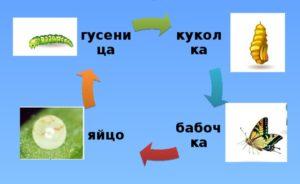Insect butterfly: beautiful and sometimes dangerous
Butterflies captivate with their fluttering beauty. They flutter so easily and innocently that a feeling of their weightlessness is created. Among them there are those that have a deceptive appearance, but in fact are pests.
Content
Photo of butterflies
Butterfly: description of the insect
The ancient Slavs believed that insects were the souls of dead people, so they were revered. They were given the appropriate name, the translation of which into modern Russian sounds like “old woman”.
Name: Lepidoptera, Butterflies, Moths
Latin: Lepidoptera LinnaeusClass: Insects - insecta
Squad: Lepidoptera
 | Habitats: | everywhere except the Arctic |
 | Features: | representatives differ in color, size and lifestyle |
 | Benefit or harm: | a type of insect that both helps and harms the economy |
Body structure
The insect itself has two main parts - a body covered with chitin and wings. In turn, the body consists of several parts.
| Head | Small, rounded, slightly flattened at the back of the head. |
| Eyes | Oval or round, color vision. |
| Mouth | Sucking or chewing type, depending on the species. |
| Chest | It consists of three segments, the front part is small. |
| Abdomen | Cylindrical shape with ten segments. |
| Antennae | Between the parietal and frontal parts, they catch odors. |
Wings
The shape, length and structure of the wings may differ depending on the species. They are covered with small scales of different colors and shapes, which are visible in macro photography.
Shades can change, they are not only an element of decor, but also a means of protection, a kind of camouflage. The size of the butterfly is also calculated by the wingspan. They can reach from 2 mm to 31 cm.
Distribution and lifestyle
Butterfly insects flutter almost all over the planet. The habitat excludes only the glaciers of Antarctica. They flutter in the highlands and in the flowering valleys.
The lifestyle of many animals is nocturnal, but many live and live during the day. In winter, some butterflies hide in cracks in the bark of trees. But there are species that survive the cold in the egg or larva stage.
Food
Nutritional preferences may vary depending on the type of animal. This:
- flowering nectar;
- honey;
- water;
- animal blood.
Some butterflies do not have a proboscis, so they eat only what they have accumulated. The caterpillar stores, pupates and turns into a beautiful moth. But the life span of this species is not long, a few days.
Reproduction and life cycle
The butterfly stage is not the entire life cycle, but its final stage. Before this, the insect passes three more stages:
- egg, up to 15 days;
- larva, gnawing caterpillar;
- chrysalis, a cocoon in which a thick caterpillar turns into a fluttering butterfly.
The full cycle of life and the features of each stage are described in the article here to register:.
Butterfly classification
In the order of Lepidoptera, which include butterflies, there are more than 150 thousand various kinds. Therefore, it is not possible to clearly divide into types. There are 4 main suborders.
- Primary tooth moths, the smallest representatives, all representatives with a gnawing type of mouth apparatus.
- Proboscis butterflies, representatives with dark or brown scales.
- heterobatmia, which represent a separate family of 10 different representatives.
- Proboscis, the largest and most diverse suborder, striking in its size and species.
Yes. Wasps, spiders and predatory flies.
This is Brazilian Morpho.
Yes, but the life of such a pet is not very long.
Butterflies - friend or foe
Gardeners are very ambivalent about these insects. It's fair to consider the pros and cons of being around these creatures.
- birds feed on caterpillars;
- butterflies contribute to pollination.
- the larvae eat the tops;
- feed on inflorescences and conifers.
Conclusion
The appearance of a butterfly does not always indicate its purity and purity. Some species can significantly harm agriculture.


Wow jakshy abdan sonun